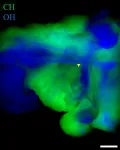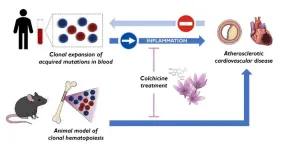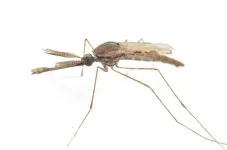(Press-News.org) A study by researchers at Baylor College of Medicine and the Jan and Dan Duncan Neurological Research Institute (Duncan NRI) at Texas Children’s Hospital, reveals that the protein Tau – a key player implicated in several neurodegenerative conditions including Alzheimer’s disease – also plays a positive role in the brain. Tau mitigates neuronal damage caused by excessive reactive oxygen species (ROS) or free radicals and promotes healthy aging. The study was published in Nature Neuroscience.
“ROS are natural byproducts of various cellular functions in the body. While low levels of ROS are beneficial, excess ROS is harmful to cells as it triggers the production of toxic forms of other molecules that induce oxidative stress, including peroxidated lipids,” said lead author Dr. Lindsey Goodman, a postdoctoral fellow in the lab of Dr. Hugo Bellen. “Neurons are particularly susceptible to oxidative stress and are destroyed if peroxidated lipid levels are not tightly controlled.”
Lipid droplets protect the brain from oxidative damage
There is mounting evidence supporting the notion that our brains have developed multiple neuroprotective strategies to combat ROS-induced oxidative damage.
One of the strategies, discovered in 2015 by the Bellen team, consists of neurons exporting these toxic peroxidated lipids to neighboring glial cells, which sequester them into lipid droplets for storage and future energy production. “This process effectively removes and neutralizes these toxic lipids,” Goodman said. “In the current study we investigated the role of Tau in the formation of glial lipid droplets.”
The team found that endogenous normal Tau in flies is required for glial lipid droplet formation and for protecting against neuronal ROS. Similarly, Tau was required in glial cells obtained from rats and humans to form lipid droplets.
And while expression of normal human Tau was sufficient to restore the process of formation and maturation of glial lipid droplets in flies lacking their own Tau, when this human Tau protein carried disease-causing mutations – which are linked to an increased risk for Alzheimer’s disease – the glia were incapable of forming lipid droplets in response to neuronal ROS.
“This argues that mutations in Tau may reduce the protein’s normal ability to prevent oxidative stress in addition to causing the protein to accumulate into the typical hallmarks of disease, as described by previous work,” said Goodman. “Altogether, the findings support a new neuroprotective role for Tau against the toxicity associated with ROS.”
Further connections with disease were discovered using established fly and rat models of Tau-mediated conditions that overexpress disease-causing human Tau protein in glia. In these scenarios, the investigators again saw defects in glial lipid droplets and glial cell demise in response to neuronal ROS. This demonstrated that Tau is a dosage-sensitive regulator of glial lipid droplets where too much or too little Tau is detrimental.
“By revealing a surprising new neuroprotective role for Tau, the study opens the door to potential new strategies to slow, reverse and treat neurodegenerative conditions,” said Bellen, corresponding author of the work. He is a distinguished service professor in molecular biology and genetics at Baylor and holds a Chair in Neurogenetics at Duncan NRI. Bellen also is a March of Dimes Professor in Developmental Biology at Baylor.
In summary, contrary to its usual ‘bad guy’ role in neurodegenerative disease, this study demonstrates that Tau also plays a ‘good guy’ role in glia by helping sequester toxic lipids, reducing oxidative damage and, hence protecting our brains. However, when Tau is absent or when defective Tau proteins are present, this protective effect disappears, leading to disease.
For the complete list of authors and their institutional affiliations, see the publication.
This work was supported by several grants from the National Institutes of Health, the Canadian Institutes of Health and Research Doctoral Award, Sloan Research Fellowship from the Alfred P. Sloan Foundation, Canada Research Chairs program, a CIHR project grant and a Grant-in-Aid for Scientific Research on Challenging Research (Exploratory). More details on other funding sources related to data collection can be found here.
###
END
Not just a ‘bad guy,’ Tau also plays a ‘good guy’ role protecting our brains
2024-08-30
ELSE PRESS RELEASES FROM THIS DATE:
Doughnut-shaped region found inside Earth’s core deepens understanding of planet’s magnetic field
2024-08-30
A doughnut-shaped region thousands of kilometres beneath our feet within Earth’s liquid core has been discovered by scientists from The Australian National University (ANU), providing new clues about the dynamics of our planet’s magnetic field.
The structure within Earth’s liquid core is found only at low latitudes and sits parallel to the equator. According to ANU seismologists, it has remained undetected until now.
The Earth has two core layers: the inner core, a solid layer, and the outer core, a liquid layer. Surrounding the Earth’s core is the mantle. The ...
Study combines data, molecular simulations to accelerate drug discovery
2024-08-30
Researchers from the University of Cincinnati College of Medicine and Cincinnati Children’s Hospital have found a new method to increase both speed and success rates in drug discovery.
The study, published Aug. 30 in the journal Science Advances, offers renewed promise when it comes to discovering new drugs.
“The hope is we can speed up the timeline of drug discovery from years to months,” said Alex Thorman, PhD, co-first author and a postdoctoral fellow in the Department of Environmental and Public ...
NCT/UCC Dresden: Millions in funding from the Chan Zuckerberg Initiative for state-of-the-art imaging to accurately detect minute tumors
2024-08-30
The imaging techniques currently used in biological research cannot penetrate into deeper tissue layers. In cancer treatment, this means that remnants of tumors or individual cancer cells at tumor margins and in lymph nodes are not visible. Doctors performing surgery are therefore repeatedly faced with the difficult question of whether all of the affected tissue has actually been removed. For the patient's quality of life, however, the complete removal of the tumor is just as essential as the preservation of healthy tissue ...
CNIC scientists discover a new cardiovascular risk factor and identify a drug able to reduce its effects
2024-08-30
To the known risk factors for cardiovascular disease—high blood pressure, high cholesterol, diabetes, overweight and obesity, smoking, and physical inactivity—a new one has to be added: clonal hematopoiesis. This condition is triggered by acquired mutations in blood stem cells and was already known to be associated with an elevated cardiovascular risk. However, until now it was uncertain if clonal hematopoiesis was a cause or consequence of cardiovascular disease. Now, a new study published in Nature Medicine and carried out by researchers at the Centro Nacional de Investigaciones Cardiovasculares (CNIC) resolves this critical debate ...
When the heat makes you disoriented
2024-08-30
Climate change is affecting ecosystems in many different ways. One of its consequences are increasingly longer and more intense periods of heat, which affect essential natural processes – such as pollination. A team of researchers from Julius-Maximilians-Universität Würzburg (JMU) has now investigated in more detail how heat affects one particular player in these processes: The bumblebee.
"Bumblebees are important pollinators in natural and agricultural systems. They therefore ...
Showcasing latest AI updates, Insilico Medicine attends 2024 EFMC International Symposium on Medicinal Chemistry
2024-08-30
Attracting around 1,000 participants from industry and academia, the XXVIII EFMC International Symposium on Medicinal Chemistry (EFMC-ISMC) is supposed to take place in Rome, Italy from September 1-5, 2024. After the generative AI updates recently announced on the IMGAIA webinar, Insilico Medicine will be sharing more innovative details while exploring collaboration chances at Booth #50.
EFMC-ISMC is a key symposium in the field of medicinal chemistry and drug discovery, and the symposium this year features ...
Novel chemical tool aims to streamline drug-making process
2024-08-30
COLUMBUS, Ohio – The invention of a tool capable of unlocking previously impossible organic chemical reactions has opened new pathways in the pharmaceutical industry to create effective drugs more quickly.
Traditionally, most drugs are assembled using molecular fragments called alkyl building blocks, organic compounds that have a wide variety of applications. However, because of how difficult it can be to combine different types of these compounds into something new, this method of creation ...
New discoveries about how mosquitoes mate may help the fight against malaria
2024-08-30
Link to Google Drive folder containing images with caption and credit information:
https://drive.google.com/drive/folders/1UM9rl47Xd_Bs-ov0HpVwC-rtUDonM3oJ?usp=sharing
Post-embargo link to release:
https://www.washington.edu/news/2024/08/30/mosquito-swarm/
Embargoed by Current Biology
For public release at 11 a.m. U.S. Eastern Time (8 a.m. U.S. Pacific Time) on Friday, Aug. 30, 2024
A high-pitched buzzing sound in your ear is an unmistakable sign that a female mosquito is out on the hunt — for they, not males, drink blood. Hearing ...
It’s worth challenging that troubling medical bill, study finds
2024-08-30
Many people who receive a problematic medical bill don’t challenge it – but new USC Schaeffer Center research shows they are likely missing out on a chance for financial relief.
About 1 in 5 people said they recently received a medical bill they disagreed with or couldn’t afford, including 61.5% who said they contacted a billing office to address their concern, according to survey results published Aug. 30 in JAMA Health Forum. Most who reached out said they received some form of payment help or had their bill corrected.
It’s ...
New study finds Medicare Advantage (MA) enrollees experience similar declines in frailty over one year compared with Traditional Medicare (TM) enrollees
2024-08-30
Enrollment in Medicare Advantage (MA) plans is not associated with altered frailty trajectories compared with enrollment in Traditional Medicare (TM), according to research published today in JAMA Network Open.
In the article Frailty in Medicare Advantage Beneficiaries and Traditional Medicare Beneficiaries, lead author Sandra M. Shi, MD, MPH and colleagues suggest that more work is needed to better understand the health services needs of older adults with frailty.
“A growing proportion of the population is enrolling in Medicare Advantage (MA), which typically ...




